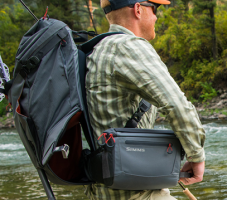Our local REI store is one of the gigantic ones with everything under the sun inside. Always a fun visit as we are hikers and occasional campers, but now we live in a place with properly cold weather and a ton more precipitation. It's a fairly safe bet that if you move from Los Angeles to anywhere else in the country, you'll be stopping into an REI before too long. (So we're in REI a lot in general.)
But this time I had fun playing around with specific gear I was considering for this fishing trip.
1) Mosquito head cover + sun/fishing hat = bought. The serious fishermen joining me on this trip implied that mosquito netting is effectively useless if it can rest on your neck or ears (bugs will bite through it), so you need a full peripheral brim of the hat to tent it away. Done. I was shocked how many sun/fishing hats they carry, and some are inexplicably over $100. (Mine was $20.)
2) As a photo comment, they carry
a nontrivial amount of Peak Design gear, FYI. If you don't have a photography store near you, you can go to REI to try a few of them out. A year ago, I actually tried out their 5L sling in the store before eventually purchasing one.
3) They sell (but do not rent) dry bags that certainly would fit a 5D3 + attached 100-400 (in this store, near the boats/kayaks area), and they ran anywhere from $80-150 depending on size and design. Unfortunately, they are paper thin compared to the thick/rubbery ones I've rafted in, walked Zion Narrows with, etc. I was fully expecting no internal padding, but these were using ultra-light membranes (plus the fairly ubiquitous roll-top seal these things prefer to employ) that did not instill confidence. These seemed like higher end shells/raincoats in bag form, and I wanted something more substantial -- I'm sure those keep rain out, but I'm much more worried about a plunge into the drink in this case). Good thing we've got a marine biologist in the family, and I'm hopeful that I can commandeer one of their more old-school dry bags for this trip.
4) The quest for a slick multi-tool has gone from 'I think this trip justifies the expense' to 'I think they are neato but I don't really need it' as the fishing ace on this trip will have each boat geared with pliers and jaw spreaders and what not. So I fiddled around with the Leatherman Skeletool CX and one of the Wave designs but opted against.
Anyway, I'm nearly there with the inventory planning, but walking through an REI, Cabela's, etc. is a good way to shake the tree for things you didn't plan to bring. It didn't spur me to buy a ton of things, but it was a decent sounding board to flesh out the plan. In some cases, it just reminded me to add things to the inventory that I already owned.

- A

